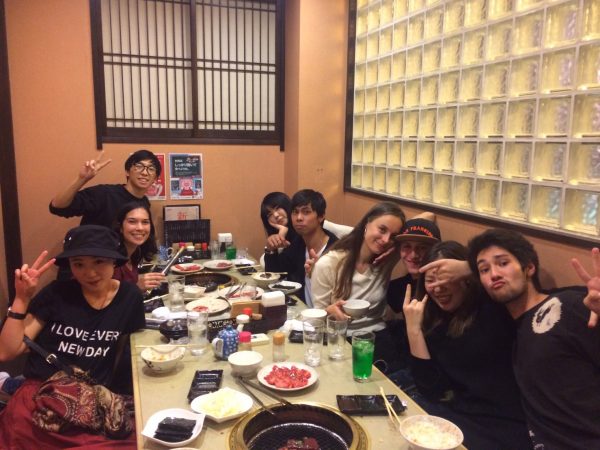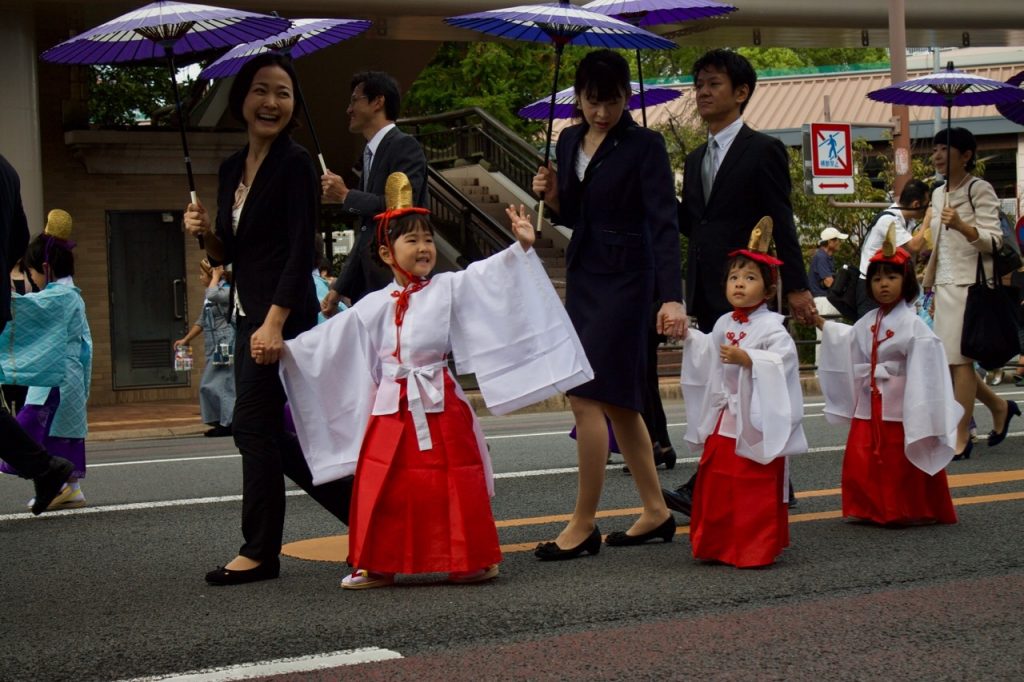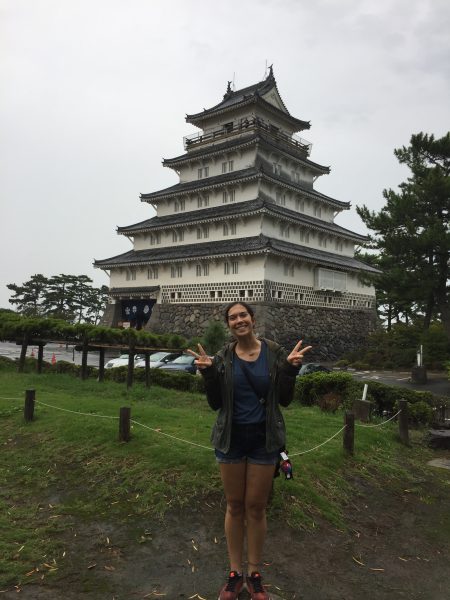Jan. 3, 2019
Shelly Peer’s dorm room is tiny—half the size that of a room shared as a first-year college student at Northern Arizona University. She’s had rice at every meal for the last three months. Many of her friends do not speak English as their first language, and they communicate in a variety of tongues. While out to dinner with a fellow student and he ordered his favorite appetizer because he wanted her to try out, she was more than a little shocked when the server put an entire fish, eyes and all, on the table in front of her.
These are the life experiences that come while studying abroad—in Peer’s case, a semester in Nagasaki, Japan, during her senior year.
These could just be events she writes in a journal or emails her friends at home about, never thinking about the history behind the use of rice or the cultural norms that influence how young women and young men interact with each other. Instead, through her participation in a new class at NAU, these are moments that she analyzes, discusses and considers in social, cultural and historical contexts while comparing them to her experiences in the United States and the experiences of other NAU students studying throughout the world.
“For the first time in my life, I am the minority,” Peer, an English major, said. “We are called Gaijin in Japan, which is slang for foreigners. Despite the constant feeling of eyes on my back (out of curiosity, never hostility), I find it a humbling experience. I am putting aside my own cultures, customs and social norms and adapting to a new environment with different cultural expectations.”
The class, ANT 499, is intended to invite students who are abroad to think critically about their experiences and actually learn from their experiences, said senior anthropology lecturer Britton Shepardson, a world traveler himself who is teaching the class. ANT 499 is a placeholder; when it is on the schedule through the liberal studies program, it will be known as Strangers in a Strange Land.
“That perspective, having someone around you to help you unravel the experience is an education that’s equally valuable to what we do here on a daily basis,” Shepardson said.
The class origin
Mariel Goble, then-Education Abroad adviser in NAU’s Center for International Education (she now works in the Interdisciplinary Global Program), and Zach Tobin, former assistant director in Education Abroad, came up with the idea for this course a couple of years ago. The course is intended to accomplish a couple of purposes. One, Goble said, is to provide a sense of community and support. Unlike many schools, NAU has direct exchange study abroad, which requires the students to find their own housing, sign up for their own classes and basically be responsible for themselves. Many universities use providers, which offer more logistical support, take care of housing and registration, plan field trips, have monthly meetings and so on, but which are more expensive.
This class, then, provides a way for study abroad students to learn from and interact with other study abroad students, even if they’re not studying on the same continent.
“Some of the culture shock is global,” Shepardson said. “It doesn’t matter where you’re coming from or where you’re going, people find similarities in their experiences.”
It also offers a way to require students to engage with and learn from their new environments. NAU wants students to explore the countries, learn about their history, economy and government as well as their traditions around food, holidays, religion and language. Goble said they want students to actually learn skills like international competency, flexibility and adaptability—the skills most students add to their resumé after a study abroad.
That, then, was the intent. Goble and Tobin discussed the challenges and experiences they’d had studying and living abroad and put together a syllabus, then approached Shepardson, who regularly leads students on study abroad experiences to help with his archaeological research on Easter Island. He refined their syllabus, adding some anthropological theories and assignments to it, and they introduced a course that encouraged students to interact with their host homes and their peers around the world in more involved, meaningful ways.
Seven students signed up for the class this semester. They represent seven different majors and are in six countries spread out across four continents.
Course curriculum
ANT 499 includes 16 assignments, which are a mix of reading, writing and experiencing their new culture through a specific lens. No two are the same. Some are mostly introspection: How did packing go? What is the food like? What is the architecture like? What do people do for fun? How do you get around? Others ask for specific experience. One assignment is to write about a piece of performance art that captures elements of the host country’s unique culture. Another is to discuss one particular historical event that left a lasting impact on the country’s political system. (Peer wrote about the nuclear bombs that her home country dropped on her host country to end World War II.) The first in-country assignment asks students to examine the culture through the lens of the anthropological theory of diffusionism.
“All of them attempt to help students relay their experiences and analyze their experiences critically from a variety of different perspectives and anthropological theories,” Shepardson said. “We’re hoping that they come home with a better understanding of personal experiences, world geography, economics, politics and religion.”
None of the writing assignments are long, though some do require analysis and research and most require some level of introspection and critical thinking. This isn’t merely a travelogue or recitation of the week’s activities. The assignments require students to truly learn about their host culture, get a clear-eyed, fresh look at their own culture and consider how the two are the same, how they’re different and what those similarities and differences signify.
Assignments are due not-quite-weekly; Shepardson sends out a reminder email and is available to answer questions, but the work is largely student-driven. They’ve risen to the responsibility, he said, turning assignments in on time, with most truly interested in wrestling with the questions.
Once they’re in, Amanda Williamson and Holly Wheeler, both education abroad advisers in the Center for International Education, grade the assignments, as does Shepardson. All three said they were impressed reading the students’ thoughts.
“A lot have delved deeply into anthropological theory and some of the historical basis for it, including the cultural norms that allow society to be structured that way,” Williamson said.
She discussed one student, who’s studying in Costa Rica, who is observing machismo culture: a subculture of overt masculinity, based on the idea that women are subservient. She examined this culture at length, analyzing how it compares to the United States and gender roles as a whole. A student in Greece has discussed at length how Greek culture doesn’t really get started until noon, which means she is adjusting her schedule from what she’s grown accustomed to throughout her life.
Students abroad are not all on the same schedule; universities in much of Europe, Asia and Oceania often don’t start until October, while in Latin America they’re in class by August and in Africa students are likely to start their semester in July. They also go for different time periods; students who participate in the Interdisciplinary Global Program spend two semesters abroad, with one semester taking classes and the other doing an internship or research. With a little flexibility and trial and error, they’re making the schedules work for everyone, Goble said.
When they return, students have the option to sign up for a one-credit course intended to both help students process their experience, including their homecoming, and help turn that experience into something they can put on resumes, discuss cogently in job interviews and point to when someone asks what they did for three months in Chile.
“Re-entry shock can be more difficult than culture shock,” Goble said. “You come back, you have all these stories, and the first day your family and friends are really excited for you, and the second day they’re not as excited.”
In this class, they’ll actually meet once a week, giving the students the chance to interact with the cohort they’ve only known virtually up to that point. The major project for that class is turning their photos and writing assignments into a travel journal that will then get published. The student gets one, and another copy goes to the Study Abroad program to provide future potential study abroad students the chance for an in-depth dive at what the experience is like.
“For most students studying abroad, especially when they’re the only NAU student at one of our partner universities, it can sometimes feel isolating,” Wheeler said. “This course allows students to not only communicate with each other and process their comparative experiences, but also find solidarity in the fact that they are challenging themselves to step outside of their comfort zones and overcoming similar challenges in vastly different environments.”

Why?
It’s hard to answer the question of why students should take this class without first addressing the bigger question: why should students study abroad?
Peer can take that one.
“I wanted to experience a culture different from my own, and the Japanese culture has always fascinated me,” she said. “Japan is a country brimming with traditional values, aesthetics and customs that bred unique practical arts, performing arts and sports that aren’t seen anywhere else in the world. As a writer, I hope to use my experiences of Japanese culture as influence for my stories.”
Goble can too.
“I think students need that extra perspective,” she said. “It just makes you open your mind, whether you want to or not. It makes you think twice and question a little bit more. You are going to realize what you’re capable of, what you’re not capable of and what you want of the future.”
Shepardson will take a run at it as well.
“I think perspective is becoming more and more important, especially the way local and national politics are going,” he said. “Political leaders are really encouraging people to fear things that are different than ourselves, and in many cases to judge them as inferior. The motivation for people to come together certainly is not going to come from our leaders. It’s got to be from the bottom up.
“For students to actually develop the habit to seek out diversity is really important. We talk about tolerance or celebration of diversity, and those things are good, but they’re not nearly enough. We have to actively seek out diversity in order to sustain it. Realistically, you just can’t appreciate what you have here unless you see it from another perspective and you see how other people live.”
As for the class, students and administrators alike said following the curriculum offered students the opportunity to engage with their new culture in a way that’s not required of tourists or even students who don’t get away from their cohorts or classrooms much. Goble said, when she lived in China, she needed almost two years to build herself up to have a real, in-depth conversation with a Chinese person in Chinese. Most students only go abroad for one semester.
“They can’t wait a year or two to have that conversation,” Goble said. “The point of studying abroad is not only to learn another culture but to adapt these skills that you can apply in any culture.”





